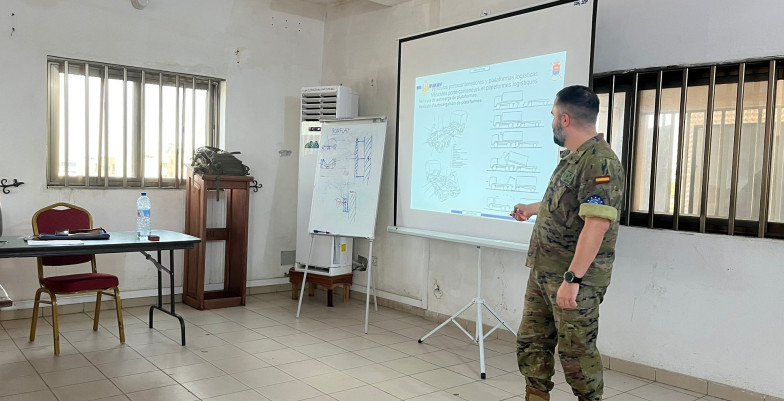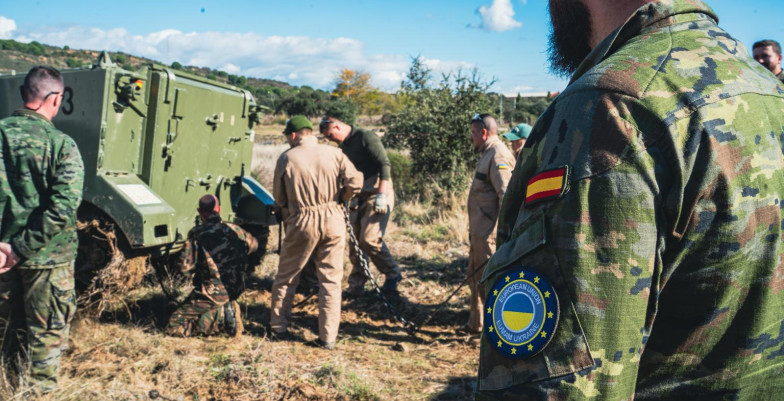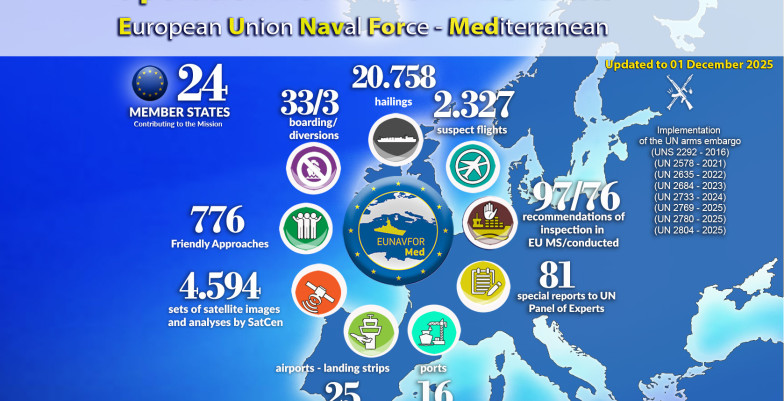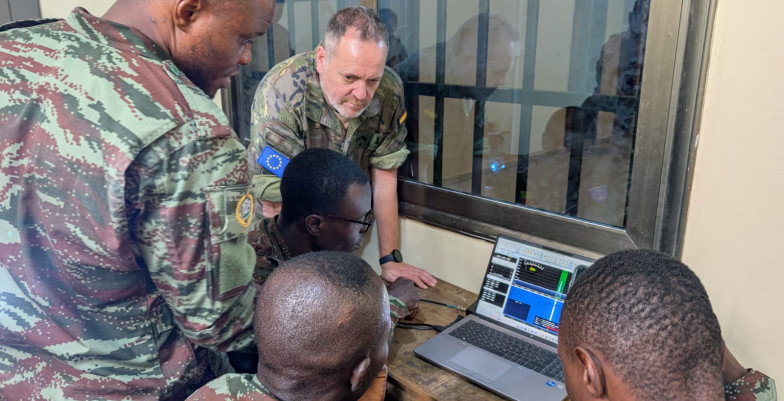Other EU defence initiatives and programmes
Over the past decade, the EU and Member States have developed EU’s defence policy through a number of key initiatives, culminating with European Defence Readiness 2030. Discover more about how the EU works in support of European defence through collaborative projects, coordination, and major programmes – to address a rapidly-changing geopolitical landscape.
On This Page
- Why launch EU defence initiatives?
- PESCO, the permanent Structured Cooperation on defence
- The Coordinated Annual Review on Defence (CARD) and Capability Development Plan
- European Defence Fund
- CARD, CDP, PESCO, EDF: different tools to boost defence cooperation
- Military Mobility
- EDIS, the European Defence Industrial Strategy
Why launch EU defence initiatives?
In light of a changing security environment, the Global Strategy for the EU’s Foreign and Security Policy in 2016 started a process of closer cooperation in security and defence.
EU Member States agreed to step up the EU’s work in this area and acknowledged the need for enhanced coordination, increased investment and more cooperation in developing defence capabilities.
The EU defence initiatives put in place – namely the Structured Cooperation, the Coordinated Annual Review on Defence and the Capability Development Plan – were subsequently complemented and supported by important instrument and policies, such as the European Defence Fund, Military Mobility, and since 2024 - the European Defence Industrial Strategy.
Scroll down to discover how.
PESCO, the permanent Structured Cooperation on defence
PESCO – the permanent Structured Cooperation on defence – is a Treaty-based framework to deepen defence cooperation amongst EU Member States who are capable and willing to do so. Through PESCO, 26 participating Member States are able to jointly plan, develop and invest in shared capability projects, and to enhance the operational readiness and contribution of their armed forces.
Through PESCO, the objective for Member States is to:
- increase their effectiveness in addressing security challenges and delivering next generation capabilities, and
- advancing towards further integrating and strengthening defence cooperation within the EU framework.
This will enhance the EU’s capacity as an international security actor, contribute to the protection of EU citizens and maximise the effectiveness of defence spending.
The Structured Cooperation on defence are mainly implemented through commitments and collaborative projects.
PESCO projects must have a clear European added value in addressing the Union’s capability and operational needs, in line with the EU Capability Development Priorities and the Coordinated Annual Review on Defence (CARD). The projects contribute to fulfilling the more binding commitments and achieving the EU Level of Ambition.
There are 75 ongoing PESCO projects. They are:
- Developed in the context of PESCO covered domains such as training, land, maritime, air, cyber, space – as well as joint enablers;
- Bringing Member States together to develop new capabilities, to train and exercise together or pool expertise in certain areas;
- Designed to deliver capabilities for the use of Member States, including to support the Common Security and Defence Policy (CSDP) Missions and Operations;
- Providing an opportunity for the participating Member States to cooperate in all domains.
Examples of projects include the establishment of a European Medical Command, Cyber Rapid Response Teams, Military Disaster Relief, Maritime Surveillance, the creation of a European Military Space Surveillance Awareness Network, specialised Helicopter Training as well as co-basing, which would allow the joint use of national and overseas bases.
PESCO is built on commitments taken by the participating Member States on defence spending, planning and harmonisation, operational cooperation, and addressing capability shortfalls collaboratively, and strengthening the European Defence Technological and Industrial Base. The specificity of PESCO compared to other form of cooperation is the legally binding nature of these commitments.
While membership of the Permanent Structured Cooperation is only for those Member States who have undertaken the more binding commitments, third States may exceptionally be invited to participate in PESCO projects upon certain conditions. For example Canada, Norway and the United States were invited to take part in the Military Mobility project in 2021, as were the United Kingdom in 2022 and Switzerland in 2025.
The Structured Cooperation undergo Strategic Reviews on a regular basis to keep it fit for purpose.
The possibility for EU member states to engage – on a voluntary basis – in Permanent Structured Cooperation in the area of defence was introduced by the Lisbon Treaty in 2009.
Learn more about PESCO.
The Coordinated Annual Review on Defence (CARD) and Capability Development Plan
Defence is a national competence and Member States are in the driving seat. To promote defence cooperation and reach greater strategic convergence, the 2016 Global Strategy called for the gradual synchronisation of national defence planning cycles and capability development.

European Union
In November 2016, the Council in its Conclusions, invited the HRVP/Head of the European Defence Agency (EDA) to present proposals on the scope, modalities and content of a Coordinated Annual Review on Defence (CARD). The CARD report, drafted by the EDA on a yearly basis, builds on information shared by EU Member States voluntarily and individual bilateral dialogues with them. It presents the main results of the review as well as associated recommendations.
Since its full launch in 2019, the Coordinated Annual Review on Defence:
- helps foster capability development, addressing shortfalls,
- deepen defence cooperation, and
- ensure more optimal use, including coherence, of defence spending plans.
The objective of the Review is to develop, on a voluntary basis, a more structured way to deliver identified capabilities based on greater transparency, political visibility and commitment from Member States.
For the CARD to provide real added value, it is of great importance to ensure the most up-to-date and detailed information possible is collected from Member States on defence plans (including spending plans), as well as the implementation of the EU capability development priorities resulting from the ‘Capability Development Plan’.
The Capability Development Plan has been produced by the EDA since 2008, in close cooperation with its Member States and with the active contributions of the EU Military Committee and the European Union Military Staff. The Capacity Development Plan looks at future security scenarios and makes recommendations about the capabilities EU Member States’ armed forces will need to react to a variety of potential developments. This comprehensive planning method has provided a picture of European military capabilities over time that may be used by Member States’ defence planners when identifying priorities and opportunities for cooperation.
- To learn more follow the link to the European Defence Agency page about CARD
European Defence Fund
The European Defence Fund (EDF) is a European Commission’s instrument to support collaborative defence research and development.
What does it do?
- The EDF supports companies across Member States develop competitive and collaborative defence projects that will deliver innovative and interoperable defence technologies and equipment.
- It offers support and advice to participants throughout the entire cycle of research and development.
- It promotes defence cooperation among companies, research actors and between the Member States to foster innovation and develop state-of-the-art defence technology.
Under the EU’s Multiannual Financial Framework (MFF) 2021-2027, the Fund supports defence projects throughout the entire cycle of research and development, focusing on projects that have the potential to be game-changers for the armed forces of Member States.
The Fund fosters innovation and incentivises the cross-border participation of Small and Medium Entreprises (SMEs).
Projects are defined based on defence capability priorities agreed by Member States within the framework of CSDP and particularly in the context of the Capability Development Plan. Projects aim at contributing to the security and defence interests of the Union.
A budget of 7.3 billion for 2021-2027 is dedicated to the European Defence Fund:
- €2.7 billion to fund collaborative defence research
- €5.3 billion euros to fund collaborative capability development projects complementing national contributions.
Find out more about the European Defence Fund.
CARD, CDP, PESCO, EDF: different tools to boost defence cooperation
EU Defence initiatives are not meant as stand-alone tools. The Coordinated Annual Review on Defence (CARD), the Capability Development Plan (CDP), the Permanent Structured Cooperation (PESCO) and the European Defence Fund (EDF), were set up as part of a coherent EU mechanism to boost collaborative defence capability planning, development, procurement and operation.
The implementation of the priorities identified by Member States in the revised Capability Development Plan are analysed by the Coordinated Annual Review on Defence, and subsequent new collaborative projects can be launched by Member States in various formats - under PESCO, within the European Defence Agency or in other bilateral or multinational frameworks – some of which may be co-funded by the EDF.
Military Mobility
Facilitating the movement of military personnel and assets is essential for the EU and Member State to be more responsive and effective in tackling today’s threats and challenges.
Military Mobility is an EU initiative to ensure the swift and seamless movement of military personnel, material and assets, including at short notice and large scale – within and beyond the EU. It aims to create a well-connected network, with shorter reaction times, and secure and resilient infrastructure.

European Union
Through the Military Mobility Action Plan 2022-2026:
- We invest in dual-use transport infrastructure along the trans-European transport network.
- We support Member States in accelerating, digitalising and simplifying national procedures and processes – such as national permissions for cross-border transit.
- We make sure transport infrastructure is prepared, adapted to military movement and resilient.
- We enhance cooperation with NATO and key partners.
Thanks to Military Mobility, Member States will be able to react faster and more effectively at the EU’s external borders and beyond. Better transport infrastructure – such as roads, railways, water ways and airports, used by both civilian and military users – across Europe will help avoid bottlenecks for large-scale movements, for instance due to insufficient height or lead capacity of bridges and railways.
Currently, the EU works on the next package in support of Military Mobility. Russia’s war of aggression against Ukraine calls for additional, urgent measures to enable our armed forces to respond quickly to threats or emergencies – and move military assistance swiftly.
Facilitating the movement of troops and equipment is essential for more effective and joined-up EU defence. Learn more about Military Mobility on the EU DEFIS website.
EDIS, the European Defence Industrial Strategy
Strengthening the European defence industry and achieving ‘defence industrial readiness’ is key to protect EU citizens. Partners, including Ukraine, will also benefit of it.
To this end, in 2024, the High Representative and the Commission, in coordination with the European Defence Agency, presented the first-ever European Defence Industrial Strategy (EDIS).
EDIS is a joint communication that sets a vision for the European defence industrial policy until 2035.
It aims at:
- Strengthening the European Defence Technological and Industrial Base (EDTIB) through increased, more collaborative and European investment from Member States;
- Improving the responsiveness of the European defence industry under any circumstances and time horizon;
- Mainstreaming a defence readiness culture, including across EU policies;
- Teaming up with our strategic, like-minded and international partners such as Ukraine and NATO.
In order to start implementing concrete measures identified in the European Defence Industrial Strategy, the European Commission has proposed a European defence industry programme (EDIP). EDIP is a Regulation proposed by the Commission, through which the EU aims to provide €1.5 billion from the EU budget in the form of grants by 31 December 2027. It will:
- Strengthen the competitiveness and responsiveness of the EDTIB;
- Ensure the availability and supply of defence products;
- Promote cooperation with Ukraine on the recovery, reconstruction and modernisation of its defence industry.
EDIP has been transmitted to the co-legislators (the European Parliament and Council) following the ordinary legislative procedure. The co-legislators will now discuss the regulation proposal with a view to its adoption and entry into force.
EDIS factsheet.
Learn more about EDIS and EDIP.








